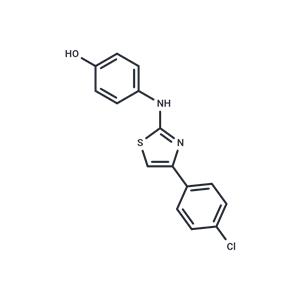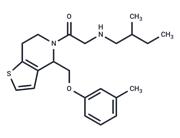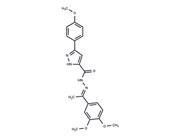| Name | SKI II |
| Description | SKI II (SphK-I2) is a highly selective and non-ATP-competitive S1P receptor inhibitor (IC50: 0.5 μM) while exhibiting no inhibitory action on other kinases including PKCα, PI3K, and ERK2. |
| Cell Research | T24, MCF-7, MCF-7/VP, and NCI/ADR cells are plated into 96-well tissue culture plates at ~15% confluency. After 24 hours, cells are treated with various concentrations of inhibitors. After an additional 48 hours, cell survival is assayed using the sulforhodamine B assay.(Only for Reference) |
| Kinase Assay | SK Assay: A medium-throughput assay suitable for screening for inhibitors of recombinant human SK has been established. Briefly, 5 μg of purified GST-SK fusion protein are combined with 12 nM sphingosine, which contains a 100-fold dilution of [3-3H]sphingosine (20 Ci/mmol), 1 mM ATP, 1 mM magnesium chloride, and 200 μL of assay buffer [20 mM Tris HCl (pH 7.4), 20% glycerol, 1 mM beta-mercaptoethanol, 1 mM EDTA, 20 mM zinc chloride, 1 mM sodium orthovanadate, 15 mM sodium fluoride, and 0.5 mM 4-deoxypyridoxine]. Assays are run for 30 min at 25°C with shaking and contains either 1% DMSO or 5 g/mL test compound, which corresponds to concentrations of 10–25 μM. The reactions are terminated with 50 μL of concentrated ammonium hydroxide, followed by extraction of the assay mixture with chloroform:methanol (2:1). The aqueous portion is transferred to scintillation vials and radioactivity is quantified as a measure of [3H]]S1P formation using a Beckman LS 3801 Scintillation Counter. The intra-assay coefficient of variation is ~10%, whereas interassay variation is ~20%. |
| In vitro | SKI II (50 mg/kg, i.p.) improves bronchial smooth muscle hyperreactivity induced by antigens in mice by inhibiting the production of endogenous sphingosine-1-phosphate. In a homologous Balb/c mouse model with JC mammary carcinoma cells, SKI II (50 mg/kg, i.p./p.o.) significantly reduces tumor growth without evident toxicity or weight loss compared to the control group. |
| In vivo | Consistent with its role in reducing S1P levels, SKI II induces apoptosis in T24 cells. In JC cells, SKI II decreases S1P formation in a concentration-dependent manner (IC50: 12 μM). Additionally, in the breast cancer cell line MDA-MB-231, SKI II significantly inhibits endogenous SK activity. Among various human cancer cell lines, including T-24, MCF-7, MCF-7/VP, and NCI/ADR, SKI II demonstrates notable antiproliferative effects (IC50: 4.6/1.2/0.9/1.3 μM). Furthermore, SKI II reverses the cisplatin resistance in SGC7901/DDP by downregulating P-gp expression and inducing apoptosis through the downregulation of SPHK1. |
| Storage | Powder: -20°C for 3 years | In solvent: -80°C for 1 year | Shipping with blue ice. |
| Solubility Information | DMSO : 40 mg/mL (132.11 mM), Sonication is recommended.
|
| Keywords | SKI II | Sphingosine kinase | Apoptosis | SphK | Wnt | Inhibitor | inhibit |
| Inhibitors Related | Stavudine | 5-Fluorouracil | Acetylcysteine | Kaempferol | Myricetin | Sodium 4-phenylbutyrate | L-Ascorbic acid | Dextran sulfate sodium salt (MW 4500-5500) | Metronidazole | Sorafenib | Tributyrin | Lidocaine hydrochloride |

 United States
United States



